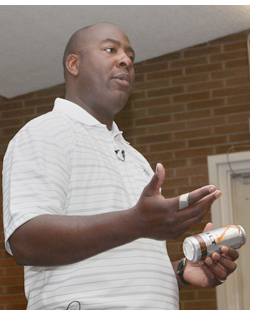
| CONNECTIONS |
IDAHO
ITD
HOME
511 TRAVEL SERVICES
IDAHO
DMV
ITD
NEWS
HIGHWAY
SAFETY
IDAHO STATE POLICE
STATE OF IDAHO
NIATT
NATIONAL
AASHTO
AAMVA
AAA of IDAHO
FEDERAL HIGHWAYS
FEDERAL AVIATION
IDAHO STATE POLICE
NHTSA
NTSB
TRB
U.S. DOT
TRANSPORTER
Archives
Milestones
Comments
Idaho
Transportation
Department
Office of Communications
P.O. Box 7129
Boise, ID 83707
208.334.8005
Fax: 208.334.8563

Teenagers finding new source of alcohol
in burgeoning energy drink market, officer explains
(Note: This is the first of two articles that address the rising use of alcohol and drugs among teenagers. Next week’s conclusion will deal with teen drug use. Boise Police officer Jermaine Galloway presented the information at Headquarters.)
The cans are big, colorful and sport names like Joose, Sparks, Max and Four Loko. Each container also may contain an alcohol wallop equivalent to four or five beers, plus an eye-opening measure of caffeine.
It’s a combination that appeals to many of today’s young drinkers, said Boise Police officer Jermaine Galloway.
 Galloway presented a shortened version of his daylong community-training program about underage drinking, alcohol and drug trends to a receptive crowd at Headquarters last week. The ITD Headquarters’ Safety Committee sponsored the program.
Galloway presented a shortened version of his daylong community-training program about underage drinking, alcohol and drug trends to a receptive crowd at Headquarters last week. The ITD Headquarters’ Safety Committee sponsored the program.
To understand how alcoholic energy drinks seem to be marketed to younger drinkers, begin with the popularity of nonalcoholic energy drinks among youth, he said.
“Teenagers and young adults are the main consumers of this product. Thirty-one percent of 12- to 17-year-olds and 34 percent of 18-to 24-year-olds report that they regularly consume energy drinks.”
Nonalcoholic energy drink producers promote youth consumption using “grassroots” level marketing strategies rather than traditional television, radio, magazine and outdoor advertising, according to a report by the Marin Institute, an alcohol industry watchdog.
“Companies are looking for ‘one-on-one relationships’ gained through events, extreme sports sponsorships, Internet interactions, text messaging, and communication among users on Internet sites such as MySpace and Facebook,” the report states.
Alcoholic energy drink producers build on the popularity of nonalcoholic energy drinks in two ways: by promoting the mixing of energy drinks with alcohol; and marketing premixed alcoholic energy drinks. Efforts to encourage the mixing of alcohol with energy drinks have led to a new category of premixed alcoholic energy drinks.
 Sometimes it is difficult to readily distinguish between energy drinks and alcohol-laden energy drinks, Galloway said, and that seems to be deliberate. Many energy drinks loaded with caffeine, ginseng, taurine, herbs and vitamins look innocent enough, but many have an alcohol-laced twin. Containers appear similar, but minors cannot legally purchase those containing alcohol.
Sometimes it is difficult to readily distinguish between energy drinks and alcohol-laden energy drinks, Galloway said, and that seems to be deliberate. Many energy drinks loaded with caffeine, ginseng, taurine, herbs and vitamins look innocent enough, but many have an alcohol-laced twin. Containers appear similar, but minors cannot legally purchase those containing alcohol.
Marketing of both products operates below most people’s social and cultural radar.
“At least 40 percent of the community doesn’t know about these drinks,” Galloway said.
Energy drinks with alcohol and “alco pop” appeal to young people, because they are marketed to young people, he said.
“Alco pop” differs from energy drinks with alcohol in that it doesn’t have the energy component. An example would be Mike’s Hard Lemonade, sold in most grocery and convenience stores.
“Drinks with alcohol are typically about $1 less in price than the non-alcohol counterpart,” Galloway explained, “and young people like that.”
Most disturbing is that can sizes are growing – ranging from 23 oz. to a whopping 32 oz. for a can of Core, which contains 11 percent alcohol. That translates into about nine beers for $3. Some drinks push the alcohol content as high 13 to 14 percent, content equivalent to wine and just short of being sold only in state liquor dispensaries.
“Become familiar with the cans, because you will see them,” he said. “Younger people know exactly what they are drinking, but most parents don’t know.”
Published 6-11-2010